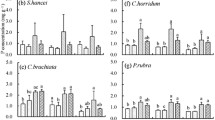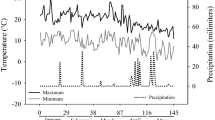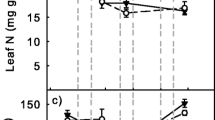Abstract
The sensitivity of tissue nutrient concentrations to changes in plant age and the supply of P and N was compared between leaves and associated twigs in two forest species. In a young regrowth stand, tissues were sampled on three occasions from the mid-crown position of karri (Eucalyptus diversicolor F. Muell.) and Bossiaea laidlawiana Tovey and Morris, a major understorey legume. Leaves and twigs were also sampled from young plants of B. laidlawiana growing in a mature eucalypt stand to which P treatments had been applied.
Nitrogen application increased N concentrations in twigs of karri and B. laidlawiana, but not in leaves. Phosphorus application increased P concentrations in both leaves and twigs of karri but the average increases were proportionally greater in twigs (65%) than in leaves (36%). Over the sampling period, P concentrations in leaves declined, while those in twigs were relatively stable. In B. laidlawiana, P supply also had a larger effect on P concentrations in twigs than in leaves. Addition of 200 kg P ha−1 increased average P concentrations in twigs by 109% in the regrowth stand and by 215% in the mature stand while the corresponding increases in leaves were only 11% and 27%. Concentrations of other nutrients in both species were also affected by N and P application, the most notable being a decline in the concentrations of the minor nutrients, Zn and Cu, with increased P supply.
The increased N concentrations in twigs of karri, and the increased P concentrations in tissues of both species, were associated with responses of karri to added N and P, and of B. laidlawiana to added P. This indicates that tissue concentrations of N and P were generally below critical concentrations where N and P were not applied. The results show that for these species twigs may be a better tissue than leaves for diagnosing deficiencies or predicting N and P requirements. The ratio of P concentrations in twigs to P concentrations in leaves also increased with added P. It is suggested that this ratio may be a useful index if it reduces the variability caused by sampling position within the crown or genetic differences between plants.
Similar content being viewed by others
References
BarrowN J 1977 Phosphorus uptake and utilization by tree seedlings. Aust. J. Bot. 25, 571–584.
BatesT E 1971 Factors affecting critical nutrient concentrations in plants and their evaluation: A review. Soil Sci. 112, 116–130.
BoumaD 1983 Diagnosis of mineral deficiencies using plant tests. In encyclopedia of Plant Physiology, New Series Vol. 15A. Inorganic Plant Nutrition. Eds, ALäuchli and R LBieleski. pp 120–146 Springer-Verlag, Berlin.
CromerR N, CameronD, CameronJ N, FlinnD W, NielsenW A, RaupachM, SnowdonP and WaringH D 1981 Response of eucalypt species to fertilizer applied soon after planting at several sites. Aust. For. 44, 3–13.
CromerR N and WilliamsE R 1982 Biomass and nutrient accumulation in a planted E. globulus (Labill.) fertilizer trial. Aust. J. Bot. 30, 265–278.
DellB, LoneraganJ F and PlaskettD 1983 The phosphorus response of Eucalyptus seedling, grown in a pallid zone clay treated with three levels of lime. Aust. J. Bot. 31, 231–238.
EmmertF H 1959 Chemical analysis of tissue as a means of determining nutrient requirements of deciduous fruit plants. Proc. Am. Soc. Hortic. Sci. 73, 521–547.
Goodall D W and Gregory F G 1947 Chemical composition of plants as an index of their nutritional status. Tech. Commun. 17, Imp. Bur. Hortic. Plant Crops, E Malling, 167 pp.
GroveT S 1988 The responses of trees and understorey to applied nitrogen and phosphorus in karri (Eucalyptus diversicolor) forest. For. Ecol. Manage. 23, 87–103.
HingstonF J, MalajczukN and GroveT S 1982 Acetylene reduction (N2-fixation) by jarrah forest legumes following fire and phosphate application. J. Appl. Ecol. 19, 631–645.
HuttonJ T and NorrishK 1977 Plant analyses by X-ray spectrometry. II. Elements of atomic number greater than 20. X-ray Spectrom. 6, 12–17.
KeayJ and MenagéP M A 1969 Automated distillation procedure for the determination of nitrogen. Analyst 94, 895–899.
LambD 1976 Variations in the foliar concentrations of macro and micro elements in a fast-growing tropical eucalpyt. Plant and Soil 45, 477–492.
LeafA L 1973 Plant analysis as an aid in fertilizing forests. In Soil Testing and Plant Analysis. Eds. L MWalsh and J DBeaton. pp 427–454. Soil Sci. Soc. Am. Inc., Madison, WI.
LoneraganJ F, GroveT S, RobsonA D, and SnowballK 1979 Phosphorus toxicity as a factor in zinc-phosphorus interactions in plants. Soil Sci. Soc. Am. J. 43, 966–972.
NorrishK and HuttonJ T 1977 Plant analyses by X-ray spectrometry. I. Low atomic number elements, sodium to calcium. X-ray Spectrom. 6, 6–11.
O'ConnellA M and GroveT S 1985 Acid phosphatase activity in karri (Eucalyptus diversicolor F. Muell.) in relation to soil phosphate and nitrogen supply. J. Exp. Bot. 36, 1359–1372.
RaupachM and NicollsJ W P 1982 Foliar nutrient levels and wood densitometric characteristics in clones of Pinus radiata D. Don. Aust. For. Res. 12, 93–103.
RobsonA D and LoneraganJ F 1970 Sensitivity of annual Medicago species to manganese toxicity as affected by calcium and pH. Aust. J. Agric. Res. 21, 223–232.
Robson A D 1981 Principles and approaches used in plant analysis. In Proc. Nat. Workshop on Plant Anal., Goolwa, South Australia, pp 1–7.
RobsonA D and PitmanM G 1983 Interactions between nutrients in higher plants. In Encyclopedia of Plant Physiology, New Series Vol. 15A, Inorganic Plant Nutrition. Eds. ALäuchli and R LBieleski. pp 147–180. Springer-Verlag, Berlin.
SmithP F 1962 Mineral analysis of plant tissues. Annu. Rev. Plant Physiol. 13, 81–108.
StaceH C T, HubbleG D, BrewerR, NorthcoteK H, SleemanJ R, MulcahyM J and HallsworthE G 1968 A Handbook of Australian Soils. Rellim Technical Publications, Glenside, SA, 435 p.
UlrichA 1952 Physiological bases for assessing the nutritional requirements of plants. Annu. Rev. Plant Physiol. 3, 207–228.
UlrichA and HillsF J 1973 Plant analysis as an aid in fertilizing sugar crops: Part 1. Sugar beets. In Soil Testing and Plant Analysis. Eds. L MWalsh and J DBeaton. pp 271–288. Soil Sci. Soc. Am. Inc., Madison, WI.
Van denDriessche 1974 Prediction of mineral nutrient status of trees by foliar analysis. Bot. Rev. 40, 347–394.
Author information
Authors and Affiliations
Rights and permissions
About this article
Cite this article
Grove, T. Twig and foliar nutrient concentrations in relation to nitrogen and phosphorus supply in a eucalypt (Eucalyptus diversicolor F. Muell.) and an understorey legume (Bossiaea laidlawiana Tovey and Morris). Plant Soil 126, 265–275 (1990). https://doi.org/10.1007/BF00012829
Received:
Issue Date:
DOI: https://doi.org/10.1007/BF00012829




